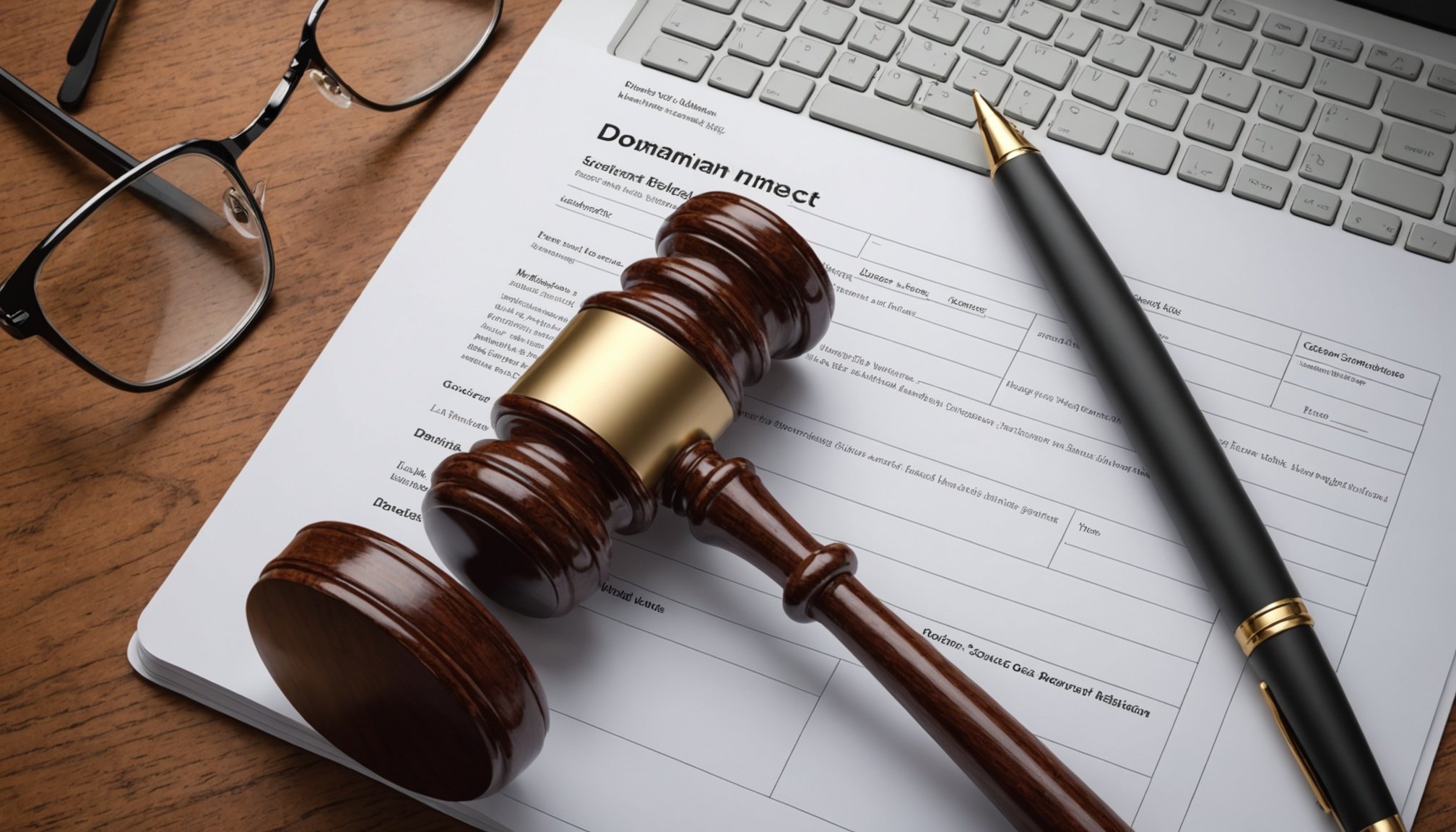Procedures for Resolving Domain Name Disputes
The resolution of domain name disputes involves several processes, each crucial in safeguarding intellectual property rights. To address these disputes effectively, understanding the methods can help parties involved reach amicable solutions.
Administrative Procedures
Administrative procedures for resolving domain name disputes often begin with a formal complaint to the appropriate authority, such as Nominet in the UK. This method typically involves the registrant and the complainant and seeks to resolve disputes through established policies.
This might interest you : Navigating UK Company Responsibilities: Mastering Compliance with the Modern Slavery Act 2015’s Anti-Slavery and Human Trafficking Statement
Court Procedures
Court procedures are more formal and involve litigation, which can be lengthy and costly. Parties may resort to this option when administrative or alternative resolutions fail. Legal representation and robust evidence are pivotal here to prove trademark infringement or cybersquatting, protecting the rightful domain ownership.
Alternative Dispute Resolution (ADR)
Alternative Dispute Resolution (ADR) methods such as mediation and arbitration provide quicker, less adversarial paths to resolve domain name disputes. Mediation encourages collaboration, while arbitration involves a neutral third party’s decision. Notably, the Nominet Dispute Resolution Service offers a structured path for initiating disputes, streamlining the process and focusing on cybersquatting legislation compliance. Leveraging these processes can significantly enhance resolution efficiency and efficacy, safeguarding domain names effectively.
Also to discover : Mastering Remote Work Policies: A UK Business Guide to Compliance with the Employment Rights Act 1996
Overview of Domain Name Conflicts
Domain name disputes arise from conflicts over the registration and usage of internet domain names. These disputes often centre around two main issues: trademark infringement and cybersquatting. Trademark infringement occurs when a domain name replicates or closely resembles a registered trademark, creating confusion over brand identity. Cybersquatting involves registering domains with the intention of profiting from another’s recognized brand, either by selling the domain to the trademark owner or diverting web traffic.
In the UK, domain name disputes have experienced a notable increase, with significant numbers reported annually. Recent data show that conflicts often involve small to mid-sized enterprises targeting brands establishing an online presence. Addressing these conflicts quickly is crucial, as prolonged disputes can lead to financial losses and reputational damage for the targeted companies.
Prompt resolution not only safeguards intellectual property rights but also ensures continuity in digital operations. Businesses facing these challenges should seek immediate solutions through administrative or alternative pathways, as these methods offer expedient results compared to traditional litigation. By understanding the nature and implications of domain name conflicts, organizations can better navigate and resolve issues efficiently.
Legal Framework for Domain Name Conflicts
Understanding the UK domain law is essential when navigating the complexities of domain name disputes. At the foundation, intellectual property laws protect domain names, considering them pivotal assets in a digital business strategy. Cybersquatting legislation targets the malicious practice of registering domain names identical or similar to trademarks, intending to profit or disrupt rightful ownership.
Key legal terms include “infringement,” which refers to unauthorized use of trademarks, and “bad faith,” pivotal in proving cybersquatting. The legislation empowers victims to reclaim their domains, deterring unauthorized exploitation.
Furthermore, the role of intellectual property law extends beyond just recovery. It serves as a deterrent, making potential squatters and infringers aware of consequences. For instance, in cases of proven infringement or bad faith, courts can order the transfer or cancellation of domain registrations, thereby upholding the integrity and value of established brands.
Incorporating a solid understanding of these laws can ensure that organizations are proactive and strategic, aligning closely with their overall brand protection efforts. Familiarity with these key concepts enables stakeholders to act swiftly and effectively, which is vital for maintaining a secure digital presence.
Case Studies of Domain Name Conflicts
Real-life examples of domain name conflicts provide invaluable insights into the complexities and outcomes of these disputes. In the UK, high-profile cases often set legal precedents that shape future domain name law. For instance, the ‘O2.co.uk’ case, where telecommunication giant O2 successfully reclaimed its domain from a cybersquatter, highlights the effectiveness of robust intellectual property laws.
These cases teach several lessons, particularly the importance of acting swiftly. In the ‘o2.co.uk’ case, O2’s immediate legal action demonstrated the critical need for timely intervention in safeguarding domain assets. This proactive approach often determines the success or failure of reclaiming contested domains.
Court rulings not only resolve individual disputes but also influence current legal frameworks. They clarify ambiguous areas, refine cybersquatting legislation, and reinforce the consequences of illegal domain registrations.
Understanding these cases assists businesses in navigating complex domain name conflicts with strategic effectiveness. For instance, ensuring trademarks are registered and monitored regularly can prevent misuse or unlawful registrations. By learning from these past conflicts, companies can better prepare to safeguard their digital assets, contributing to more secure and reliable brand protection.
Best Practices for Securing Domain Names
Proactively securing domain names is vital in safeguarding a company’s digital footprint. A strategic approach to domain registration can help mitigate the risks of trademark infringement and cybersquatting. Vital steps include ensuring that domain names closely align with the brand identity and checking their availability across multiple top-level domains (TLDs).
Conducting due diligence before acquiring a domain is essential. This process involves verifying the domain’s history and ensuring it does not have existing ties to any legal issues. Tools such as Whois can provide insights into a domain’s past ownership and usage, reducing potential legal risks associated with acquisition.
Furthermore, maintaining trademark protection is an ongoing requirement in the digital landscape. Registering trademarks and regularly monitoring them online ensures any misuse is quickly identified and addressed. Companies should consider investing in domain monitoring services, which offer real-time alerts about potential infringements or similar domain registrations.
Finally, businesses should educate stakeholders about best practices in domain security. This includes regular audits of domain portfolios and understanding the implications of UK domain law concerning any registered or prospective domain names. Implementing these practices offers more secure and reliable brand protection.
Understanding Regulatory Bodies
Understanding the pivotal roles played by regulatory bodies is crucial for navigating the complexities of domain name disputes. In the UK, Nominet serves as a key figure in the regulation of domain names. As the official registry for .uk domain names, Nominet oversees the registration and transfer processes, thus helping maintain order and fairness in domain name allocation.
Role of Nominet
Nominet’s responsibilities extend beyond just registration. They offer a Dispute Resolution Service, which provides an alternative to court procedures by resolving conflicts such as cybersquatting and trademark infringement in a more streamlined manner. This service aims to protect intellectual property by making dispute resolution accessible and less costly.
Other Relevant Regulatory Bodies
Aside from Nominet, other regulators like ICANN play significant roles internationally. They implement policies to ensure domain authority and compliance. These bodies collaborate with regional entities to enforce cybersquatting legislation effectively.
Compliance and Enforcement Mechanisms
Regulatory frameworks include precise compliance and enforcement mechanisms to uphold domain integrity. Reporting mechanisms allow parties to address issues promptly, reducing the chance of prolonged domain name disputes. Organizations that understand these layers of regulation can better protect their online interests and take preemptive actions against potential conflicts.
Preventative Measures for Enterprises
In today’s digital age, safeguarding a company’s brand protection against domain name disputes is vital. Implementing effective legal strategies and domain monitoring can help deter issues like cybersquatting and trademark infringement before they arise.
Preventive measures begin with a clear brand protection strategy. By regularly updating and maintaining a comprehensive list of domain names that align with a brand’s identity, businesses ensure control over their online presence. This strategic approach not only mitigates risks but also instills trust and confidence among consumers.
Utilising tools and services for domain monitoring is another proactive step. These resources continuously track domain registrations, providing alerts about suspicious activities or potential infringements. Services such as WHOIS and domain watch programs are particularly effective in flagging any unauthorised registrations.
Legal strategies play a crucial role in prevention. Registering trademarks promptly and ensuring their protection through regular monitoring can avert costly disputes. Employing a team knowledgeable in UK domain law ensures that businesses are well-prepared to act swiftly if any issues arise. Additionally, educating stakeholders about these prevention strategies can further strengthen an entity’s resolve in combating potential threats related to domain names.









